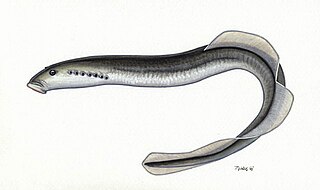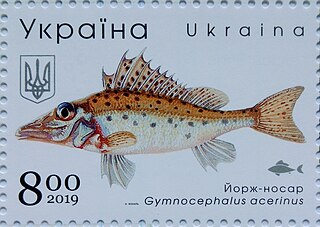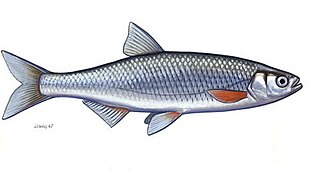
The ide, or orfe, is a freshwater fish of the family Cyprinidae found in larger rivers, ponds, and lakes across Northern Europe and Asia. It has been introduced outside its native range into Europe, North America, and New Zealand. It is a popular ornamental fish, usually kept in outdoor ponds in temperate regions from which it often escapes.

The common dace is a species of freshwater and brackish water ray-finned fish from the family Cyprinidae which is native to Europe but which has been introduced to other parts of the world. It is a quarry species for coarse anglers.

Stenodus leucichthys is a species of freshwater whitefish in the family Salmonidae. In the strict sense its natural distribution is restricted to the Caspian Sea basin. It is now considered extinct in the wild, but survives in cultured stocks. The nelma, a more widespread species of Eurasian and North America, is sometimes considered its subspecies.

The huchen, also known as Danube salmon or redfish, is a large species of freshwater fish in the family Salmonidae native to the Danube basin in Central and Eastern Europe. It is the type species of genus Hucho, being closely related to salmon, trout, char and lenoks.

The common bleak is a small freshwater coarse fish of the cyprinid family.

The asp is a European freshwater fish of the Cyprinidae family. It is sometimes considered by taxonomic authorities to be one of two members of the genus Aspius. It is protected under Appendix III of the Bern Convention and listed as least concern on the IUCN Red List.

The broad whitefish is a freshwater whitefish species. Dark silvery in colour, and like a herring in its shape. Its distinctive features includes: a convex head, short gill rakers, and a mild overbite. It is found in the Arctic-draining streams, lakes, and rivers of far eastern Russia and North America. Its prey includes larval insects, snails, and shellfish. It is eaten by humans and brown bears.

The sterlet is a relatively small species of sturgeon from Eurasia native to large rivers that flow into the Black Sea, Azov Sea, and Caspian Sea, as well as rivers in Siberia as far east as Yenisei. Populations migrating between fresh and salt water (anadromous) have been extirpated. It is also known as the sterlet sturgeon.

Alburnus is a genus of fish in the family Cyprinidae, the carps and minnows. They are known commonly as bleaks. A group of species in the genus is known as shemayas. The genus occurs in the western Palearctic realm, and the center of diversity is in Turkey.

The Kessler's gudgeon is a European species of freshwater fish in the family Cyprinidae. It is found in the Danube and Vistula drainage basins, including parts of Poland, Austria, the Czech Republic, Ukraine, Bulgaria, Romania, Moldova, Hungary, Croatia, Bosnia and Herzegovina, Serbia, Montenegro, Slovakia, and Slovenia. It is a small fish of no economic or sporting importance. It was at one time classified as Gobio kessleri.

Romanogobio uranoscopus, also known as the Danubian longbarbel gudgeon, Danubian gudgeon, Danube gudgeon or the steingressling, is a European species of freshwater cyprinid fish. It can be found in Austria, Bulgaria, Croatia, Czech Republic, Germany, Hungary, Italy, Romania, Serbia and Montenegro, Slovakia, Slovenia and Ukraine.

Eudontomyzon danfordi, the Carpathian brook lamprey or Danube lamprey, is a species of lamprey in the family Petromyzontidae. It is found in Austria, Bosnia and Herzegovina, Bulgaria, Croatia, Czech Republic, Hungary, Moldova, Romania, Serbia, Montenegro, Slovakia, and Ukraine. Unlike other brook lampreys, this fish is parasitic.

The Donets ruffe is a species of perch native to eastern Europe where it occurs in the basins of the Black Sea and the Sea of Azov. They inhabit freshwater lakes and rivers usually over hard compacted sand. They are predominantly crepuscular and prey mostly on invertebrates, rarely on fish. They are inactive during winter months, and usually move to deeper places until the ice melts. Spawning occurs in small rivers with heavy currents. This species reaches a length of 21 centimetres (8.3 in) SL.
The Caspian lamprey, Caspiomyzon wagneri, is a species of lamprey native to the Caspian Sea, and a member of the Petromyzontidae family. This species is a non-parasitic lamprey that feeds on animal carcasses.
Stenodus nelma, known alternatively as the nelma, sheefish, siifish, inconnu or connie, is a commercial species of freshwater whitefish in the family Salmonidae. It is widespread in the Arctic rivers from the Kola Peninsula eastward across Siberia to the Anadyr River and also in the North American basins of the Yukon River and Mackenzie River.

Alburnus arborella is a species of ray-finned fish in the carp family Cyprinidae. It is a freshwater fish occurring in lakes and streams in Europe. It is distributed in Croatia, Italy, Slovenia, and Switzerland.

Alburnus mento is a species of freshwater fish, a bleak in the family Leuciscidae. Its distribution is in subalpine lakes in Germany and Austria.

Alburnus sarmaticus is a species of ray-finned fish in the genus Alburnus. Widespread in European rivers: Southern Bug, Dnieper, Danube ; River Kolpa, an upper tributary to the River Sava in Croatia and Slovenia. Almost extirpated in Danube, to be probably survived only in River Kolpa.
The Terek nase is a species of freshwater fish in the family Cyprinidae. It is distributed in rivers of the western Caspian Sea basin, in Azerbaijan and Russia. It prefers fast-flowing waters in the foothill and mountain ranges, with rocky or gravel bottoms.
The Volga undermouth or Volga nase is a species of cyprinid freshwater fish. This one lives in the Emba, Ural, and Volga drainages of the Caspian Sea basin and the Don River drainage of the Black Sea basin.
















